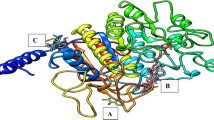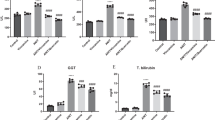Abstract
In the modern world, indiscriminate human activities impelled environmental toxicity through heavy metals such as cadmium (Cd) that poses significant health hazards to the flora and fauna. Multiple mechanisms such as oxidative stress, inflammation, apoptotic cell death, and chromosomal aberrations underlie the Cd-induced organ toxicity with the liver and kidneys bearing most of the brunt. Fumaric acid (FA) is an organic acid (C4H4O4) omnipresent in nature and attributed with such properties (e.g., antioxidant, anti-inflammatory, analgesic, chemopreventive, anti-psoriatic, immunomodulatory, and neuroprotective) that may bestow relief in Cd-induced liver damage. Hence, in the present study, the protective effects of FA were determined in Cd-induced hepatotoxicity in rats. Wistar rats were chronically exposed to Cd (5 mg/kg, p.o.) to induce liver dysfunction. The rats were subjected to FA (1.25, 2.5, 5 mg/kg; p.o.) pre-treatment for 28 days to observe effects on liver and serum biomarkers of oxidative stress, enzymatic activities, and hepatic damage (liver histopathology). Body weights, feed/water intake, body mass index (BMI), and non-invasive parameters (FIB-4 score; AST/ALT ratio) were quantified. Cd-triggered hepatic injury in rats through oxidative stress, derangement of hepatic serum biomarkers (ALT, AST, ALP, LDH, bilirubin, cholesterol, triglycerides, uric acid, and platelet count), and pathogenic alteration in non-invasive parameters. FA pre-treatment significantly protected rat livers against Cd toxicity by decreasing oxidative stress and improving the hepatic serum biomarkers and non-invasive parameters. In a histopathological analysis, FA prevented Cd-accrued hepatocellular damage. Fumaric acid showed potential to avert hepatic injury against cadmium in rats.

Graphical abstract





Similar content being viewed by others
References
Adefegha SA, Omojokun OS, Oboh G (2015) Modulatory effect of protocatechuic acid on cadmium induced nephrotoxicity and hepatoxicity in rats in vivo. Springerplus. 4:619. https://doi.org/10.1186/s40064-015-1408-6
Ahuja M, Ammal Kaidery N, Yang L, Calingasan N, Smirnova N, Gaisin A, Gaisina IN, Gazaryan I, Hushpulian DM, Kaddour-Djebbar I, Bollag WB, Morgan JC, Ratan RR, Starkov AA, Beal MF, Thomas B (2016) Distinct Nrf2 signaling mechanisms of fumaric acid esters and their role in neuroprotection against 1-methyl-4-phenyl-1,2,3,6-tetrahydropyridine-induced experimental Parkinson’s-like disease. J Neurosci. 36(23):6332–6351. https://doi.org/10.1523/JNEUROSCI.0426-16.2016
Andjelkovic M, Buha Djordjevic A, Antonijevic E, Antonijevic B, Stanic M, Kotur-Stevuljevic J, Spasojevic-Kalimanovska V, Jovanovic M, Boricic N, Wallace D, Bulat Z (2019) Toxic effect of acute cadmium and lead exposure in rat blood, liver, and kidney. Int J Environ Res Public Health. 16(2):274. https://doi.org/10.3390/ijerph16020274
Angulo P, Hui JM, Marchesini G, Bugianesi E, George J, Farrell GC, Enders F, Saksena S, Burt AD, Bida JP, Lindor K, Sanderson SO, Lenzi M, Adams LA, Kench J, Therneau TM, Day CP (2007) The NAFLD fibrosis score: a noninvasive system that identifies liver fibrosis in patients with NAFLD. Hepatology. 45(4):846–854. https://doi.org/10.1002/hep.21496
Balak DM (2015) Fumaric acid esters in the management of psoriasis. Psoriasis (Auckl). 5:9–23. https://doi.org/10.2147/PTT.S51490
Bernhoft RA (2013) Cadmium toxicity and treatment. Scientific World Journal. 394652:1–7. https://doi.org/10.1155/2013/394652
Ellman G (1959) Tissue sulfhydryl groups. Arch Biochem Biophys. 82(1):70–77. https://doi.org/10.1016/0003-9861(59)90090-6
Hall P, Cash J (2012) What is the real function of the liver ‘function’ tests? Ulster Med J. 81(1):30–36
Hartwig A (2013) Cadmium and cancer. Met Ions Life Sci. 11:491–507. https://doi.org/10.1007/978-94-007-5179-8_15
Hyder O, Chung M, Cosgrove D, Herman JM, Li Z, Firoozmand A, Gurakar A, Koteish A, Pawlik TM (2013) Cadmium exposure and liver disease among US adults. J Gastrointest Surg. 17(7):1265–1273. https://doi.org/10.1007/s11605-013-2210-9
Kang MY, Cho SH, Lim YH, Seo JC, Hong YC (2013) Effects of environmental cadmium exposure on liver function in adults. Occup Environ Med. 70(4):268–273. https://doi.org/10.1136/oemed-2012-101063
Kono Y (1978) Generation of superoxide radical during autoxidation of hydroxylamine and an assay for superoxide dismutase. Arch Biochem Biophys. 186(1):189–195. https://doi.org/10.1016/0003-9861(78)90479-4
Kronenberg J, Pars K, Brieskorn M, Prajeeth CK, Heckers S, Schwenkenbecher P, Skripuletz T, Pul R, Pavlou A, Stangel M (2019) Fumaric acids directly influence gene expression of neuroprotective factors in rodent microglia. Int J Mol Sci. 20(2):325. https://doi.org/10.3390/ijms20020325
Li S, Tan HY, Wang N, Zhang Z-J, Lao L, Wong C-W, Feng Y (2015) The role of oxidative stress and antioxidants in liver diseases. Int J Mol Sci. 16(11):26087–26124. https://doi.org/10.3390/ijms161125942
Luck H (1965) Catalase. In: Bergmeyer HU (ed) Method of enzymatic analysis. Academic Press, New York, USA, pp 885–894. https://doi.org/10.1016/B978-0-12-395630-9.50158-4
McGuire VA, Ruiz-Zorrilla Diez T, Emmerich CH, Strickson S, Ritorto MS, Sutavani RV et al (2016) Dimethyl fumarate blocks pro-inflammatory cytokine production via inhibition of TLR induced M1 and K63 ubiquitin chain formation. Sci Rep. 6:31159. https://doi.org/10.1038/srep31159
Moharregh-Khiabani D, Linker RA, Gold R, Stangel M (2009) Fumaric acid and its esters: an emerging treatment for multiple sclerosis. Curr Neuropharmacol. 7(1):60–64. https://doi.org/10.2174/157015909787602788
Noura OA, Shehatou GSG, Rahim MA, El-Awady MS, Suddek GM (2017) Antioxidant and anti-inflammatory effects of dimethyl fumarate in hypercholesterolemic rabbits. Egypt J Basic Appl Sci. 4(3):153–159. https://doi.org/10.1016/j.ejbas.2017.07.003
Ohkawa H, Ohishi N, Yagi K (1979) Assay for lipid peroxides in animal tissues by thiobarbituric acid reaction. Anal Biochem. 95(2):351–358. https://doi.org/10.1016/0003-2697(79)90738-3
Padilla MA, Elobeid M, Ruden DM, Allison DB (2010) An examination of the association of selected toxic metals with total and central obesity indices: NHANES 99-02. Int J Environ Res Public Health. 7(9):3332–3347. https://doi.org/10.3390/ijerph7093332
Rafati Rahimzadeh M, Rafati Rahimzadeh M, Kazemi S, Moghadamnia AA (2017) Cadmium toxicity and treatment: an update. Caspian J Intern Med. 8(3):135–145. https://doi.org/10.22088/cjim.8.3.135
Rani A, Kumar A, Lal A, Pant M (2014) Cellular mechanisms of cadmium-induced toxicity: a review. Int J Environ Health Res. 24(4):378–399. https://doi.org/10.1080/09603123.2013.835032
Rotruck J, Pope A, Ganther H, Swanson A, Hafeman D, Hoekstra W (1973) Selenium: biochemical role as a component of glutathione peroxidase. Science. 179(4073):588–590. https://doi.org/10.1126/science.179.4073.588
Shakya A, Singh GK, Chatterjee SS, Kumar V (2014) Role of fumaric acid in anti-inflammatory and analgesic activities of a Fumaria indica extracts. J Intercult Ethnopharmacol. 3(4):173–178. https://doi.org/10.5455/jice.20140912021115
Williams AL, Hoofnagle JH (1988) Ratio of serum aspartate to alanine aminotransferase in chronic hepatitis. Relationship to cirrhosis. Gastroenterology. 95(3):734–739. https://doi.org/10.1016/s0016-5085(88)80022-2
Wollina U (2011) Fumaric acid esters in dermatology. Indian Dermatol Online J. 2(2):111–119. https://doi.org/10.4103/2229-5178.86007
Xu G, Zou W, Chen X, Xu N, Liu L, Chen J (2012) Fumaric acid production in Saccharomyces cerevisiae by in silico aided metabolic engineering. Plos one. 7(12):e52086. https://doi.org/10.1371/journal.pone.0052086
Acknowledgments
The authors are thankful to the all the management committee member of the Amar Shaheed Baba Ajit Singh Jujhar Singh Memorial College of Pharmacy, BELA (Ropar), for providing the necessary research facilities.
Author information
Authors and Affiliations
Contributions
ASK conceptualized and designed the study. GK performed the experiments and collected the data. TBS and MK analyzed the data. ASK and MK drafted and revised the manuscript. All authors read and approved the manuscript. It is stated that all data were generated in-house and no paper mill was used.
Corresponding author
Ethics declarations
All the experiments were performed as per the ethical guidelines on animal experimentations provided by the Committee for the Purpose of Control and Supervision of Experiments on Animals (CPCSEA), GOI, New Delhi.
Conflict of interest
The authors declare that they have no conflict of interest.
Additional information
Publisher’s note
Springer Nature remains neutral with regard to jurisdictional claims in published maps and institutional affiliations.
Electronic supplementary material
ESM 1
(XLSX 82 kb)
Rights and permissions
About this article
Cite this article
Kaur, G., Shivanandappa, T.B., Kumar, M. et al. Fumaric acid protect the cadmium-induced hepatotoxicity in rats: owing to its antioxidant, anti-inflammatory action and aid in recast the liver function. Naunyn-Schmiedeberg's Arch Pharmacol 393, 1911–1920 (2020). https://doi.org/10.1007/s00210-020-01900-7
Received:
Accepted:
Published:
Issue Date:
DOI: https://doi.org/10.1007/s00210-020-01900-7




